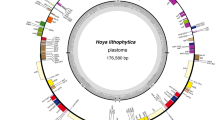Abstract
Putative PISTILLATA genes were generated in nine species of Neillia, to examine the phylogenetic relationships among the species, and to test the hypothesis of hybrid origin within the genus. The PI genes determined in Neillia have two introns in the I-box region, which is consistent with PI genes in other Rosaceae. Phylogenetic analyses of the I-box region, including the introns, indicated that the species formerly classified in Stephanandra were nested within Neillia, supporting the taxonomic merger of the two genera. The PI data do not have a sufficiently strong signal to reject the hypothesis that Stephanandra is a hybrid in origin. The PI data, in conjunction with nuclear LEAFY, ribosomal DNA, and chloroplast DNA data, suggest that N. affinis might have been derived from hybridization between N. thibetica and N. gracilis. The phylogenetic position of N. affinis in the N. thibetica clade is supported by the PI and rDNA data, whereas N. affinis is also supported as a sister to N. gracilis in the LEAFY and cpDNA data. The pattern of phylogenetic placements of N. affinis in two different clades in two different sets of data suggests that the genome of the species might be comprised of a combination of the putative parental species.
Similar content being viewed by others
References
Bailey CD, Doyle JJ (1999) Potential phylogenetic utility of the lowcopy nuclear gene pistillata in dicotyledonous plants: comparison to nrDNA ITS and trnL intron in Sphaerocardamum and other Brassicaceae. Mol Phylogent Evol 13:20–30
Baldwin JT Jr (1951) Chromosomes of Spiraea and of certain other genera of Rosaceae. Rhodora 53:203–206
Buerkle CA, Morris RJ, Asmussen MA, Rieseberg LH (2000) The likelihood of homoploid hybrid speciation. Heredity 84:441–451
Cullen J (1971) The genus Neillia (Rosaceae) in mainland Asia and in cultivation. J Arnold Arb 52:137–158
Davalos LM, Cirranello AL, Geisler JH, Simmons NB (2012) Understanding phylogenetic incongruence: lessons from phyllostomid bats. Biol Rev 87:991–1024
Drouin G, Daoud H, Xia J (2008) Relative rates of synonymous substitutions in the mitochondrial, chloroplast and nuclear genomes of seed plants. Mol Phylo Evol 49:827–831
Edgar RC (2004) MUSCLE: multiple sequence alignment with high accuracy and high throughput. Nucl Acids Res 32:1792–1797
Felsenstein J (1985) Confidence limits on phylogenies: an approach using the bootstrap. Evolution 39:783–791
Hasegawa M, Kishino H, Yano T (1985) Dating of the human-ape splitting by a molecular clock of mitochondrial DNA. J. Mol Evol 21:160–174
Hemsley WB (1892) Observations on a botanical collection made by Mr. A. E. Pratt in western China, with descriptions of some new Chinese plants from various collections. J Linn Soc 29:298–322
Huelsenbeck JP, Ronquist F (2001) MrBayes: Bayesian inference of phylogeny. Bioinformatics 17:754–755
Iwatsubo Y, Naruhashi N (1993) Chromosome number and karyotype of two Stephanandra species (Rosaceae). Cytologia 58:95–99
Järvinen P, Lemmetyinen J, Savolainen O, Sopanen T (2003) DNA sequence variation in BpMADS2 gene in two populations of Betula pendula. Mol Ecol 12:369–384
Kalkman C (1988) The phylogeny of the Rosaceae. Bot J Linn Soc 98:37–59
Krak K, Caklova P, Chrtek J, Fehrer J (2013) Reconstruction of phylogenetic relationships in a highly reticulate group with deep coalescence and recent speciation (Hieracium, Asteraceae). Heredity 110:138–151
Lee JY, Mummenhoff K, Bowman JL (2002) Allopolyploidization and evolution of species with reduced floral structures in Lepidium L. (Brassicaceae). Proc Natl Acad Sci USA 99:16835–16840
Maddison, WP (1997) Gene trees in species trees. Syst Biol 46:523–536
Morgan DR, Soltis DE, Robertson KR (1994) Systematic and evolutionary implications of rbcL sequence variation in Rosaceae. Am J Bot 81:890–903
Nixon KC, Carpenter JM (1996) On consensus: collapsibility, and clade concordance. Cladistics 12:305–321
Oh SH (2006) Neillia includes Stephanandra (Rosacaeae). Novon 16:91–95
Oh SH, Potter D (2003) Phylogenetic utility of the second intron of LEAFY in Neillia and Stephanandra (Rosaceae) and implications for the origin of Stephanandra. Mol Phylogenet Evol 29:203–215
Oh SH, Potter D (2005) Molecular phylogenetic systematics and biogeography of tribe Neillieae (Rosaceae) using DNA sequences of cpDNA, rDNA, and LEAFY. Am J Bot 92:179–192
Pillet L, Fontaine D, Pawlowski J (2012) Intra-genomic ribosomal RNA polymorphism and morphological variation in Elphidium macellum suggests inter-specific hybridization in Foraminifera. PLoS One 7 (2): e32373
Potter D, Eriksson T, Evans RC, Oh SH, Smedmark JEE, Morgan DR, Kerr M, Robertson KR, Arsenault M, Dickinson TA, Campbell CS (2007) Phylogeny and classification of Rosaceae. Plant Syst Evol 266:5–43
Ratter JA, Milne C (1973) Some angiosperm chromosome numbers. Notes Roy Bot Gard Edinb 32:429–438
Rieseberg LH, Baird SJ, Gardner KA (2000) Hybridization, introgression, and linkage evolution. Plant Mol Biol 42:205–224
Sambrook E, Fritzch F, Maniatis T (1989) Molecular Cloning. Cold Spring Harbor Press, Cold Spring Harbor, New York
Schulze-Menz GK (1964) Rosaceae, In H Melchior, ed, Engler’s Syllabus der Pflanzenfamilien II, Gebrüder Borntraeger, Berlin, pp. 209–218
Shimodaira H, Hasegawa M (1999) Multiple comparisons of loglikelihoods with applications to phylogenetic inference. Mol Biol Evol 16:1114–1116
Swofford DL (2002) PAUP*: phylogenetic analysis using parsimony (*and other methods), version 4.0b10. Sinauer, Sunderland, Massachusetts
Troebner W, Ramirez L, Motte P, Hue I, Huijser P, Loennig W-E, Saedler H, Sommer H, Schwarz-Sommer Z (1992) GLOBOSA: A homeotic gene which interacts with DEFICIENS in the control of Antirrhinum floral organogenesis. EMBO J 11:4693–4704
Vidal J (1963) Le genre Neillia (Rosaceae). Adansonia 3:142–166
Yao JL, Dong YH, Morris BA (2001) Parthenocarpic apple fruit production conferred by transposon insertion mutations in a MADS-box transcription factor. Proc Natl Acad Sci USA 98:1306–1311
Zhang YX, Zeng CX, Li DZ (2012) Complex evolution in Arundinarieae (Poaceae: Bambusoideae): Incongruence between plastid and nuclear GBSSI gene phylogenies. Mol Phylo Evol 63:777–797
Author information
Authors and Affiliations
Corresponding author
Rights and permissions
About this article
Cite this article
Oh, SH. Phylogenetic analysis of PISTILLATA sequences in Neillia (Rosaceae). J. Plant Biol. 56, 145–151 (2013). https://doi.org/10.1007/s12374-013-0016-7
Received:
Accepted:
Published:
Issue Date:
DOI: https://doi.org/10.1007/s12374-013-0016-7




